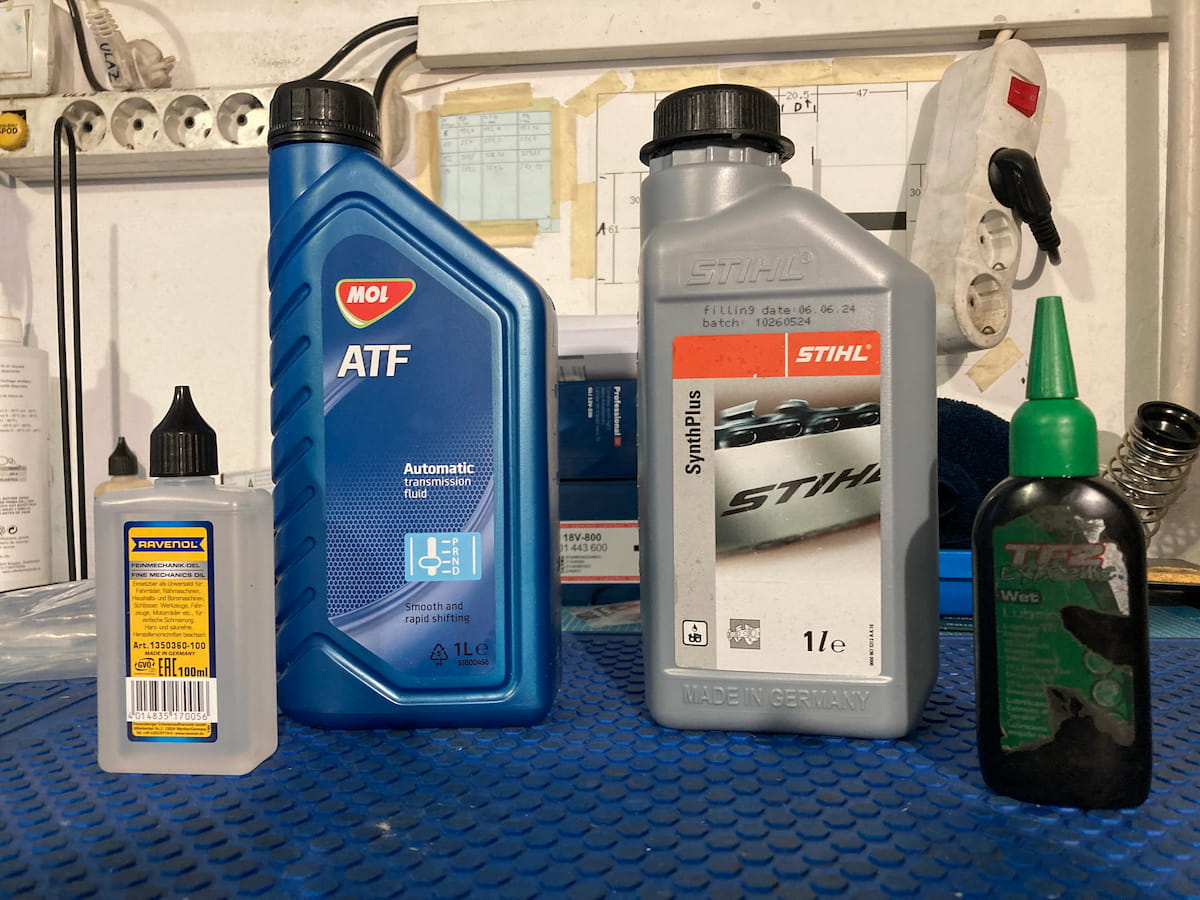BikeGremlin’s chain lube homebrew project
– A serious experiment with an unserious name
This article is the hands-on branch of my full chain lube guide – and a variant for my simple chain lube recommendation. My basic recommendation of chainsaw bar oil with some diesel mix is still working OK. This is just an attempt to make it a bit cleaner, without sacrificing longetivity and performance.
For years, I’ve been developing a homemade bicycle chain lubricant. Why? Because buying a perfectly fine commercial product is clearly too easy.
The goal:
- Lubricates well.
- Doesn’t fling off like champagne on a Tour de France podium.
- Doesn’t attract half the trail.
- Is made from stuff I can source locally without needing a hazmat permit.
What follows is the evolution of my DIY lube – one revision at a time. Latest versions come first. Testing continues.
🧪 MARK VI (currently under test)
Ingredients:
(with a brief explanation of what each ingr. does)
- 5% Odourless mineral spirits (Kluthe Lösol – Amazon.de aff. link)
Acts as a carrier solvent. It thins the mixture slightly, helping the oil penetrate into the rollers and pins of the chain. It partially evaporates, leaving behind the lubricating components.
May reduce to 3% if the lube mists too much or runs too easily during application. - 10% Fine machine oil – Amazon.de aff. link (e.g. sewing machine or spindle oil)
Provides low-viscosity lubrication and helps with smooth movement of chain links with minimal dirt accumulation. Its “low weight” complements “thicker” oils, improving flow without flinging.
May reduce to 5% if ATF proves itself as a clean-enough base. - 60% ATF (e.g. MOL ATF, MOL ATF Synt 3H or NISOTEC ATF III SINT)
Forms the base of the blend. Offers good film strength, corrosion inhibitors, detergents (though made for enclosed mechanisms), and temperature stability. ATF is designed to resist shearing and oxidation – great qualities for chain lube.
Can be adjusted depending on how much bar oil or machine oil is used. - 25% Chainsaw bar oil (Stihl SynthPlus – Amazon.de aff. link)
This is the clinging agent. Designed to stick to fast-moving chains, it reduces fling-off and provides lasting lubrication. It also adds thickness to the mix.
May increase to 35% if you’re riding in wet conditions or want a more persistent film.
Observations:
The previous version sprayed like I was trying to paint the floor. This one is thicker and designed to stay where it’s put. Results pending – expectations medium.
MARK VI is under testing. Aiming for a thicker, low-fling blend that doesn’t attract every airborne particle. Still tweaking. Still overthinking. Still better than 90% of marketing departments.
🛢 MARK V
Ingredients:
- 5% Odourless mineral spirits (Kluthe Lösol)
- 15% Fine machine oil
- 70% ATF (NISOTEC or MOL)
- 10% Chainsaw bar oil (Stihl SynthPlus)
Observations:
Transitioned from machine oil to ATF for better film strength and lubrication. Stihl SynthPlus proved far better than Nisotec Testerol. Still sprayed too much on application – thicker was needed.
🛠 MARK IV
Ingredients:
- 5% Odourless mineral spirits
- 70% Fine machine oil
- 25% Chainsaw bar oil
Observations:
Marked improvement in cling. But it still misted too much when applied. More goop, less mist needed.
🧯 MARK III
Ingredients:
- 5% Odourless mineral spirits
- 75% Fine machine oil
- 20% Chainsaw bar oil
Observations:
Better than previous. Still not ideal. Felt like I was getting close, but not quite thick enough.
🫧 MARK II
Ingredients:
- 10% Odourless mineral spirits
- 80% Fine machine oil
- 10% Chainsaw bar oil
Observations:
Fling city. Somehow managed to coat everything except the chain. Solvent content was too high – clearly.
🍼 MARK I
Ingredients:
- 10% Odourless mineral spirits
- 85% Fine machine oil
- 5% Chainsaw bar oil
Observations:
A gentle whisper of lubrication. Chain sounded tired too quickly. First attempt, under-lubed and over-diluted.
Conclusion?
If you’re tempted to try making your own, feel free to copy, tweak, and test. My basic recommendation of chainsaw bar oil with some diesel mix is still working OK. This is just an attempt to make it a bit cleaner, without sacrificing longetivity and performance.
No magic, no secrets – just practical trial and error.
And if I ever perfect this, it’ll be called simply “BPT™” because:

🔗 Related reading
If you’re looking to understand bicycle chain lubrication more thoroughly, these go deeper:
- Bicycle chain lubricants – explained
A full technical breakdown: types of lubes, viscosity, how chains wear, and what really matters. - Comparative overview of bicycle chain lubricants
Side-by-side comparison of commercial and DIY-friendly options. Includes durability, cleanliness, availability, and cost ratings. - The best bicycle chain lubricant
TL;DR: There’s no single best lube – only what fits your ride, weather, and maintenance habits. But if you’re in a hurry: chainsaw bar oil (optionally thinned). This very article is an update (hopefully an improvement) of that.

